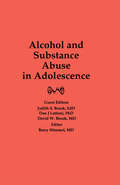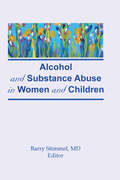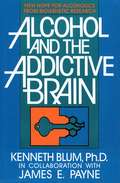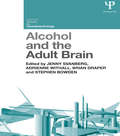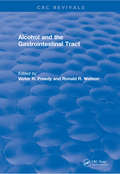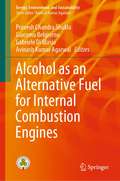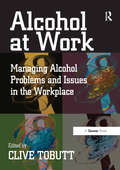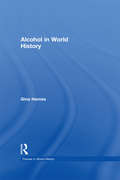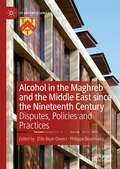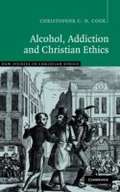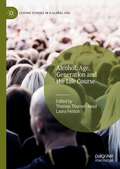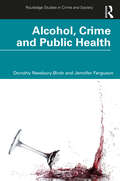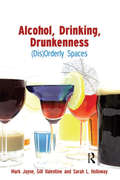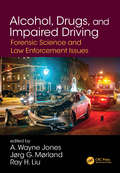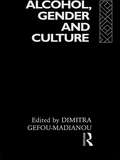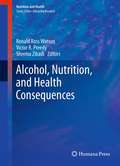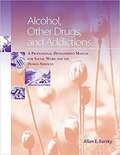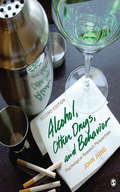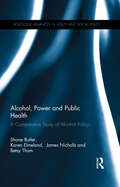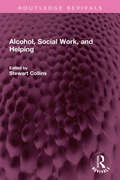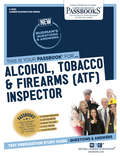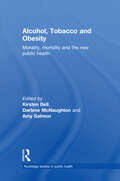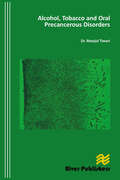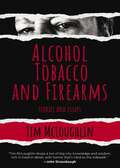- Table View
- List View
Alcohol and Substance Abuse in Adolescence
by Barry Stimmel Judith BrookThis timely volume explores the possible reasons that young people turn to drugs, the most effective methods to manage those who are afflicted, and ways to educate youth to prevent their initial drug involvement.
Alcohol and Substance Abuse in Women and Children
by Barry StimmelHere is a timely volume that examines the problems of substance abuse in women and children, with a particular emphasis on the role played by the family in the development and perpetuation of the problem.
Alcohol and Tobacco: Medical and Sociological Aspects of Use, Abuse and Addiction
by Henriette Walter Otto-Michael Lesch Christian Wetschka Michie N. Hesselbrock Victor Hesselbrock Samuel PomboThis updated and revised second edition of “Alcohol and Tobacco” reflects the new ICD 11 and DSM V classifications and provides comprehensive descriptions of new therapeutic approaches, outlining the different interactions between personality, environment and the effects of the respective substance. In addition to new data on prevention-based therapies, especially for smoking addiction, the book also presents essential psychological and sociological strategies, and medication-based therapies. Particular attention is given to new medications and new compounds for e-cigarettes, while a broad overview of the American and European epidemiology of alcohol and nicotine addictions rounds out the coverage. Given the breadth and depth of its coverage, the book will appeal to a wide readership, from professionals to researchers and students.
Alcohol and the Addictive Brain: New Hope for Alcoholics From Biogenetic Research
by Kenneth BlumA new understanding of the nature and progression of alcohol addiction is emerging: alcoholism as the result of an imbalance in the brain's natural production of neurotransmitters critical to our sense of well-being. This imbalance, which an increasing amount of evidence is demonstrating to be genetically influenced, produces a craving temporarily satisfied by drinking. "Alcohol and the Addictive Brain" is an account of the recent scientific discoveries concerning alcoholism.
Alcohol and the Adult Brain (Current Issues in Neuropsychology)
by Brian Draper Jenny Svanberg Adrienne Withall Stephen BowdenThe research literature on the impact of alcohol on the brain has seen a rapid expansion in recent years. Alcohol and the Adult Brain presents an up-to-date overview of some of the issues relevant to understanding and working with people with cognitive impairment as a result of chronic alcohol use. One issue causing barriers to effective treatment and care is the stigma associated with alcohol dependence, resulting in the belief that difficulties associated with alcohol related brain damage (ARBD) are ‘self-inflicted’. Cognitive changes resulting from alcohol excess and poor nutrition can directly affect an individual’s ability to motivate themselves, make decisions, and make the informed choices that underlie behaviour change. Attitudes held by professionals, reinforced by societal norms, that a person is ‘choosing to drink’ and ‘not motivated to engage with treatment’, in combination with the often subtle cognitive deficits associated with ARBD, can result in a lack of timely intervention, with enormous personal, social and economic cost. The chapters in this book set ARBD in a social and cultural context, provide discussion of the difficulties in definition and diagnosis, and outline the structural brain changes and neuropsychological deficits associated with chronic alcohol use. The book provides an overview of recent research on ARBD, including impairments associated with Wernicke-Korsakoff Syndrome, and discusses up to date recommendations for managing and working with this complex and varied disorder. Alcohol and the Adult Brain will be essential for students and researchers working with ARBD and for practitioners in a range of health, social care and voluntary settings.
Alcohol and the Gastrointestinal Tract (CRC Press Revivals)
by Victor R. PreedyThis book covers all aspects of gastrointestinal tract problems caused by alcohol misuse. Opening chapters discuss epidemiology and the metabolism of alcohol and the liver's role in that process. Alcohol and acetaldehyde dehydrogenases, free radicals, and endocrine changes are discussed in detail. Recent advances in the pathophysiology of alcohol-induced disorders are summarized and many chapters detail techniques such as permeability and protein synthesis. Effects on specific organs, including the salivary glands, stomach, pancreas, and small intestine, are also discussed. All contributors and both editors are internationally recognized experts in their fields.
Alcohol as an Alternative Fuel for Internal Combustion Engines (Energy, Environment, and Sustainability)
by Avinash Kumar Agarwal Pravesh Chandra Shukla Giacomo Belgiorno Gabriele Di BlasioThis book covers different aspects related to utilization of alcohol fuels in internal combustion (IC) engines with a focus on combustion, performance and emission investigations. The focal point of this book is to present engine combustion, performance and emission characteristics of IC engines fueled by alcohol blended fuels such as methanol, ethanol and butanol. The contents also highlight the importance of alcohol fuel for reducing emission levels. Possibility of alcohol fuels for marine applications has also been discussed. This book is a useful guide for researchers, academics and scientists.^
Alcohol at Work: Managing Alcohol Problems and Issues in the Workplace
by Clive TobuttIn the European Union many individuals will partake in drinking a little wine with their lunch or dinner to aid their enjoyment of the meal or as an appetizer for food. Alcohol is also a drug of dependence. Some individuals will drink too much and some of them will become addicted. Access to alcohol, binge drinking, and younger drinkers can lead to unsafe workplaces, absenteeism, fraud and criminal behaviour. Alcohol at Work is a definitive guide to the problem, exploring its nature and scale and providing a complete range of ideas and techniques to help create a policy in the workplace and develop appropriate and effective measures for monitoring and tackling alcohol abuse. The key collective message is solve the problem - take the alcohol, not the person, out of the workplace. In the UK alone, research puts the cost of alcohol abuse in the workplace at £2 billion a year. This is a must-have reference for human resource, occupational health and risk managers, as well as those involved in tackling criminal behaviour such as fraud and violence at work resulting from alcohol abuse and addiction.
Alcohol in World History (Themes in World History)
by Gina HamesFrom the origins of drinking to the use and abuse of alcohol in the present day, this global historical study draws on approaches and research from biology, anthropology, sociology and psychology. Topics covered include: the impact of colonialism alcohol before the world economy industrialization and alcohol globalization, consumer society, and alcohol. Gina Hames argues that the production, trade, consumption, and regulation of alcohol have shaped virtually every civilization in numerous ways. It has perpetuated the development of both domestic and international trade; helped create identity and define religion; provided a tool for oppression as well as a tool for cultural and political resistance; and has supplied governments with essential revenues as well as a means of control over minority groups. Alcohol in World History is one of the first studies to pull together such a wide range of sources in order to compare the role of alcohol throughout time and across both western and non-western civilizations.
Alcohol in the Maghreb and the Middle East since the Nineteenth Century: Disputes, Policies and Practices (St Antony's Series)
by Elife Biçer-Deveci Philippe BourmaudThis book explores the significance of alcohol in the Middle East and Maghreb as a powerful catalyst of social and political division. It shows that the solidarities and polarities created by disputes over alcohol are built on arguments far more complex than oppositions on religion or consumption alone. In a region in which alcohol is banned by Islamic rules, yet allows its production and consumption, alcohol has always been contentious. However, this volume examines the different forms of social authority – religious, cultural and political – to offer a new understanding of drinking behaviours in the Middle East and North Africa. It suggests that alcohol, being at the same time an import and product of local industry, epitomises the tensions inherent to the conforming of Islamic societies to global trends, which seek to redefine political communities, social hierarchies and gender roles. The chapters challenge common misconceptions about alcohol in this region, arguing instead that medical discourses on alcohol dependency hide stances on national independence in an imperialist context; that the focus on religion also tends to conceal disputes on alcohol as a social struggle; and that disputes on inebriation are more about masculinity than judging private leisure. In doing so, the volume presents alcohol as a way of grasping the power relations that structure the societies of the Middle East and Maghreb.
Alcohol, Addiction and Christian Ethics
by Stanley M. Hauerwas Christopher C. H. Cook Robin Gill Stephen R. L. Clark Robin W. LovinAddictive disorders are characterised by a division of the will, in which the addict is attracted both by a desire to continue the addictive behaviour and also by a desire to stop it. Academic perspectives on this predicament usually come from clinical and scientific standpoints, with the 'moral model' rejected as outmoded. But Christian theology has a long history of thinking and writing on such problems and offers insights which are helpful to scientific and ethical reflection upon the nature of addiction. Chris Cook reviews Christian theological and ethical reflection upon the problems of alcohol use and misuse, from biblical times until the present day. Drawing particularly upon the writings of St Paul the Apostle and Augustine of Hippo, a critical theological model of addiction is developed. Alcohol dependence is also viewed in the broader ethical perspective of the use and misuse of alcohol within communities.
Alcohol, Age, Generation and the Life Course (Leisure Studies in a Global Era)
by Thomas Thurnell-Read Laura FentonThis volume explores generational differences in alcohol consumption practices and examines the changing role of alcohol across the life course. It considers generational patterns in where, how and why people buy and consume alcohol and how these may interact with identity and belonging and considers how drinking alcohol in adolescence, adulthood, middle-age or later life takes on different functions, meanings and tensions. Alcohol is shown to play an important role in biographical transitions, such as in the coming of age rituals that mark the passage from adolescences to adulthood, whilst drinking alcohol in adulthood and in later life takes on new meanings, pleasures and risks in light of shifting roles and responsibilities relating to work, leisure and the family. The empirically-informed contributions draw on a range of diverse disciplinary backgrounds and a range of cultural contexts provides a nuanced examination of the role of alcohol at different life course stages and explores both continuity and change between generations.
Alcohol, Crime and Public Health (Routledge Studies in Crime and Society)
by Dorothy Newbury-Birch Jennifer FergusonAlcohol, Crime and Public Health explores the issue of drinking in the criminal justice system, providing an overview of the topic from both a criminal justice and a public health perspective. The majority of prisoners in the UK (70%) have an alcohol use disorder, and evidence tells us that risky drinking is high amongst those in contact with all areas of the criminal justice system. Uniquely, this book brings both a criminal justice and a public health perspective to the topic. The book opens by exploring the levels of crime attributed to alcohol, the policy context of alcohol and crime, and the prevalence of risky alcohol consumption in the criminal justice system. The following chapters examine risky drinking amongst men, women and young people in the criminal justice system. The final chapters look at the efficacy of psychosocial interventions for risky drinking in the criminal justice system, and look forward to how researchers and practitioners can work together to produce research in the criminal justice system. Written in an accessible and concise style, Alcohol, Crime and Public Health will be of great use to students of criminology, criminal justice and public health as well as the wider area of public and social policy in relation to alcohol and crime.
Alcohol, Drinking, Drunkenness: (Dis)Orderly Spaces (Studies In Early Medieval Britain Ser.)
by Gill Valentine Sarah L. Holloway Mark JayneWhile disciplines such as anthropology, sociology, politics, social policy and the health and medical sciences have a tradition of exploring the centrality of alcohol, drinking and drunkenness to people's lives, geographers have only previously addressed these topics as a peripheral concern. Over the past few years, however, this view has begun to change, accelerated by an upsurge in interest in alcohol consumption relating to political and popular debate in countries throughout the world. This book represents the first systematic overview of geographies of alcohol, drinking and drunkenness. It asks what role alcohol, drinking and drunkenness plays in people's lives and how space and place are key constituents of alcohol consumption. It also examines the economic, political, social, cultural and spatial practices and processes that are bound up with alcohol, drinking and drunkenness. Designed as a reference text, each chapter blends theoretical material with empirical case studies in order to analyse drinking in public and private space, in the city and the countryside, as well as focusing on gender, generations, ethnicity and emotional and embodied geographies.
Alcohol, Drugs, and Impaired Driving: Forensic Science and Law Enforcement Issues
by Ray H. Liu A. Wayne Jones Jørg G. MørlandAlcohol, Drugs, and Impaired Driving addresses many theoretical and practical issues related to the role played by alcohol and other psychoactive drugs on driving performance, road-traffic safety, and public health. Several key forensic issues are involved in the enforcement of laws regulating driving under the influence of alcohol and/or other drugs, including analytical toxicology, pharmacology of drug action, as well as the relationships between dose taken, concentration levels in the body, and impairment of performance and behavior. Our knowledge of drunken driving is much more comprehensive than drugged driving, so a large part of this book is devoted to alcohol impairment, as well as impairment caused by use of drugs other than alcohol. For convenience, the book is divided into four main sections. The first section gives some historical background about measuring alcohol in blood and breath as evidence for the prosecution of traffic offenders. The important role of the Breathalyzer instrument in traffic-law enforcement, especially in Australia, Canada, and the USA is presented along with a biographical sketch of its inventor (Professor Robert F. Borkenstein of Indiana University) with focus on the man, his work and his impact. The second section discusses several issues related to forensic blood and breath-alcohol alcohol analysis as evidence for prosecution of traffic offenders. This includes how the results should be interpreted in relation to impairment and an evaluation of common defense challenges. Because most countries have adopted concentration per se laws, the main thrust of the prosecution case is the suspect’s measured blood- or breath-alcohol concentration. This legal framework necessitates that the analytical methods used are "fit for purpose" and are subjected to rigorous quality assurance procedures. The third section gives a broad overview of the current state of knowledge about driving under the influence of non-alcohol drugs in various countries. This includes adoption of zero-tolerance laws, concentration per se statutes, and clinical evidence of driver impairment based on field sobriety tests and drug recognition expert evidence. The fourth section deals with epidemiology, enforcement, and countermeasures aimed at reducing the threat of drunken and drugged driving. All articles have appeared previously in the international journal Forensic Science Review, but all are completely updated with current data, references, and the latest research on developments since the articles were published. This book contains a convenient collection of the best articles covering recommendations for blood and breath testing methods, public policy relating to such methods, and forensic and legal implications of the enforcement of measures to counter driving under the influence.
Alcohol, Gender and Culture (European Association of Social Anthropologists)
by Dimitra Gefou-MadianouEuropeans consitiute 12 and a half per cent of the world's population but consume 50 per cent of the recorded world production alcohol, and this consumption plays a significant role in the cultural, religious, and social identites of these countrise. The contributors show how different groups define the proper use of alcohol, how State policies may effect drinking behaviour, and highlight how beverages and comestibles must be seen in relation to each other. From this is it shown how importamt socio-cultural distinctions are made between and within communities, gender relations, ethnic groups, and socio-economic groups, and within religious ideologies; what one drinks, how one drinks, with whom, and where, all influence not how alcoholic substances are regarded but how social relations are experienced. Alcohol Gender and Culture clearly demonstrates how the social construction of drinking may provide an analytical tool with which to approach different socio-cultural groups and illustrates how any cultural group can be compared to another by its attutudes to alcohol. It will be invaluable reading for students and lecturers af anthropology, cultural history and gender studies.
Alcohol, Nutrition, and Health Consequences (Nutrition and Health)
by Victor R. Preedy Ronald Ross Watson Sherma ZibadiChronic alcohol use is associated with heart, liver, brain, and other organ pathology. Alcohol is a drug of abuse and a caloric food and it causes poor intake and absorption of nutrients, thus playing a major role in many aspects of clinical consequences. Alcohol use lowers consumption of fruit and vegetables, lowers tissue nutrients, and, in some cases, requires nutritional therapy by clinicians. Alcohol, Nutrition, and Health Consequences will help the clinician define the causes and types of nutritional changes due to alcohol use and also explain how nutrition can be used to ameliorate its consequences. Chapters present the application of current nutritional knowledge by physicians and dietitians. Specific areas involving alcohol-related damage due to nutritional changes are reviewed, including heart disease, obesity, digestive tract cancers, lactation, brain function, and liver disease. In addition, alcohol's effects on absorption of minerals and nutrients, a key role in causing damage are treated. The importance of diet in modifying alcohol and its metabolite damage is also explained. Alcohol, Nutrition, and Health Consequences is essential reading for alcohol therapists and researchers as well as primary care physicians and dietitians and is an easy reference to help the clinician, student, and dietitian comprehend the complex changes caused by direct and indirect effects of ethanol at the cellular level via its nutritional modification.
Alcohol, Other Drugs and Addictions: A Professional Development Manual for Social Work and the Human Services
by Allan Edward BarskyTo help prepare you for the realities of working with clients affected by addictions, this beneficial text provides you with the necessary tools needed to competently translate addictions theory into practice. It offers a thorough examination of a range of models and perspectives for helping, and it encourages critical thinking to best match approaches with clients and situations. Presented in a work-text format, this book is full of cases, exercises, role-plays, and questions to increase your understanding of concepts and application to practice.
Alcohol, Other Drugs, and Behavior: Psychological Research Perspectives
by John R. JungProviding a psychological perspective on the use and abuse of alcohol and other psychoactive drugs, this Second Edition includes more coverage of the theories of alcohol and other drug use and abuse, as well as broad conceptual issues related to the nature of addiction and recent developments in research methods.Key FeaturesFocuses on alcohol, which is used more widely than any other drug, and the one that is associated with the most societal harmEvaluates important studies on major issues, concepts, and theories rather than providing exhaustive literature reviewsTeaches students to become educated consumers of research findings, rather than passive or uncritical recipientsAncillariesA Student Study Site with chapter summaries, multiple-choice quizzes, flashcards for glossary items, an annotated list of relevant Web sites, informational QuickTime movies, and SAGE journal articles.A password protected Instructor′s Resource Site includes PowerPoint slides and test questions.Intended AudienceThis text is appropriate for upper-level undergraduate courses in Drugs and Behavior, Psychology of Addiction, and Drug Abuse Counseling. It can also be used in graduate-levelcourses in Drugs and Behavior and Addiction courses taught in health science, social work, criminal justice, and nursing.
Alcohol, Power and Public Health: A Comparative Study of Alcohol Policy
by Shane Butler Betsy Thom James Nicholls Karen ElmelandIn recent years, the reduction of alcohol-related harm has emerged as a major policy issue across Europe. Public health advocates, supported by the World Health Organisation, have challenged an approach that targets problem-drinking individuals, calling instead for governments to control consumption across whole populations through a combination of pricing strategies, restrictions on retail availability and marketing regulations. Alcohol, Power and Public Health explores the emergence of the public health perspective on alcohol policy in Europe, the strategies alcohol control policy advocates have adopted, and the challenges they have faced in the political context of both individual states and the European Union. The book provides a historical perspective on the development of alcohol policy in Europe using four case studies – Denmark, England, Scotland and Ireland. It explores the relationship between evidence, values and power in a key area of political decision-making and considers what conditions create – or prevent – policy change. The case studies raise questions as to who sets policy agendas, how social problems are framed and defined, and how governments can balance public health promotion against both commercial interests and established cultural practices. This book will be of interest to academics and researchers in policy studies, public health, social science, and European Union studies.
Alcohol, Social Work, and Helping (Routledge Revivals)
by Stewart CollinsFirst published in 1990, Alcohol, Social Work and Helping provides coherent and imaginative advice on how to counsel the growing number of clients whose use of alcohol causes of problems. It locates intervention within societal and agency contexts and tackles such practical issues as: how to work with a problem drinker; which short-term goals to suggest; what kind of help to apply; and how to assist in the event of a relapse. The contributors, with backgrounds in academic, statutory, and voluntary settings, focus on key areas of intervention, family, and group contexts, and there is a chapter on the particular circumstances and needs of women. All relevant information – both general and specialized – is presented in a clear, easy-to-read style, and is aimed at developing existing knowledge and skills. This book will be of interest to students of health, social work, and sociology.
Alcohol, Tobacco & Firearms: Passbooks Study Guide (Career Examination Series #C-39)
by National Learning CorporationThe Alcohol, Tobacco and Firearms (ATF) Inspector Passbook® prepares you for your test by allowing you to take practice exams in the subjects you need to study. It provides hundreds of questions and answers in the areas that will likely be covered on your upcoming exam, including but not limited to: Investigation and inspection methods; Reading comprehension; Proper usage of vocabulary and grammar; Arithmetic reasoning; Graphs, charts and tables; and other related areas.
Alcohol, Tobacco and Obesity: Morality, mortality and the new public health
by Amy Salmon Kirsten Bell Darlene McNaughtonAlthough drinking, smoking and obesity have attracted social and moral condemnation to varying degrees for more than two hundred years, over the past few decades they have come under intense attack from the field of public health as an 'unholy trinity' of lifestyle behaviours with apparently devastating medical, social and economic consequences. Indeed, we appear to be in the midst of an important historical moment in which policies and practices that would have been unthinkable a decade ago (e.g., outdoor smoking bans, incarcerating pregnant women for drinking alcohol, and prohibiting restaurants from serving food to fat people), have become acceptable responses to the 'risks' that alcohol, tobacco and obesity are perceived to pose. Hailing from Canada, Australia, the United Kingdom and the USA, and drawing on examples from all four countries, contributors interrogate the ways in which alcohol, tobacco and fat have come to be constructed as 'problems' requiring intervention and expose the social, cultural and political roots of the current public health obsession with lifestyle. No prior collection has set out to provide an in-depth examination of alcohol, tobacco and obesity through the comparative approach taken in this volume. This book therefore represents an invaluable and timely contribution to critical studies of public health, health inequities, health policy, and the sociology of risk more broadly.
Alcohol, Tobacco and Oral Precancerous Disorders
by Munjul TiwariIt is estimated that in India 75% of cancers of oral cavity are attributable to tobacco chewing, smoking and alcohol drinking. So the purpose of this book is to present the correlations of these premalignant disorders microscopically with in tobacco users and alcohol drinkers.
Alcohol, Tobacco, and Firearms: Stories And Essays
by Tim McLoughlinAn enthralling collection of short fiction and nonfiction that draw upon McLoughlin's three-decade career in the criminal justice system. In Alcohol, Tobacco, and Firearms, Tim McLoughlin draws upon his three-decade career in the criminal justice system with his characteristic wit and his fascination with misfits and malfeasance. A lifetime immersed in New York City feeds short stories that evoke a landscape of characters rife with personal arrogance and misjudgment; and nonfiction essays about toeing the line when the line keeps disappearing. An opioid-addicted catsitter electronically eavesdrops on his neighbors only to hear devastating truths. A degenerate gambler stakes his life on a long shot because he sees three lucky numbers on the license plate of a passing car. In the nonfiction essays, we learn that the system plays a role in supporting vice, as long as it gets a cut. Altar boys compete to work weddings and funerals for tips in the shadow of predatory priests. Cops become robbers, and a mob boss just might be a civil rights icon. McLoughlin shines a light on worlds that few have access to. A recurring theme in his urban, often New York–centric work is chronic displacement, people standing still in a city that is always changing. These are McLoughlin’s ghosts, these casualties of progress, and he holds them dear and celebrates them.
